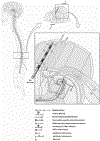Spinal Cord Stimulation: Clinical Efficacy and Potential Mechanisms
- PMID: 29526043
- PMCID: PMC6391880
- DOI: 10.1111/papr.12692
Spinal Cord Stimulation: Clinical Efficacy and Potential Mechanisms
Abstract
Spinal cord stimulation (SCS) is a minimally invasive therapy used for the treatment of chronic neuropathic pain. SCS is a safe and effective alternative to medications such as opioids, and multiple randomized controlled studies have demonstrated efficacy for difficult-to-treat neuropathic conditions such as failed back surgery syndrome. Conventional SCS is believed mediate pain relief via activation of dorsal column Aβ fibers, resulting in variable effects on sensory and pain thresholds, and measurable alterations in higher order cortical processing. Although potentiation of inhibition, as suggested by Wall and Melzack's gate control theory, continues to be the leading explanatory model, other segmental and supraspinal mechanisms have been described. Novel, non-standard, stimulation waveforms such as high-frequency and burst have been shown in some studies to be clinically superior to conventional SCS, however their mechanisms of action remain to be determined. Additional studies are needed, both mechanistic and clinical, to better understand optimal stimulation strategies for different neuropathic conditions, improve patient selection and optimize efficacy.
Keywords: complex regional pain syndromes; low back pain; pain syndromes; postoperative pain; regional complex; spinal cord stimulation.
© 2018 World Institute of Pain.
Figures


Comment in
-
Which is Preferable for Spinal Cord Stimulation: Sensor-Driven Position-Adaptive or Conventional?Pain Pract. 2019 Jul;19(6):678. doi: 10.1111/papr.12787. Epub 2019 May 21. Pain Pract. 2019. PMID: 31066989 No abstract available.
References
-
- Melzack R, Wall PD. Pain mechanisms: a new theory. Science (New York, N.Y.). 1965;150:971–979. - PubMed
-
- Smits H, van Kleef M, Holsheimer J, Joosten EA. Experimental spinal cord stimulation and neuropathic pain: mechanism of action, technical aspects, and effectiveness. Pain Pract. 2013;13:154–168. - PubMed
-
- De Ridder D, Vanneste S, Plazier M, van der Loo E, Menovsky T. Burst spinal cord stimulation: toward paresthesia-free pain suppression. Neurosurgery. 2010;66:986–990. - PubMed
-
- Spinal Cord Stimulation. Available at: http://www.aans.org/Patients/Neurosurgical-Conditions-and-Treatments/Spi... (accessed 9/18/2017).
-
- Shealy CN, Mortimer JT, Reswick JB. Electrical inhibition of pain by stimulation of the dorsal columns: preliminary clinical report. Anesth Analg. 1967;46:489–491. - PubMed
Publication types
MeSH terms
Grants and funding
LinkOut - more resources
Full Text Sources
Other Literature Sources
Medical

